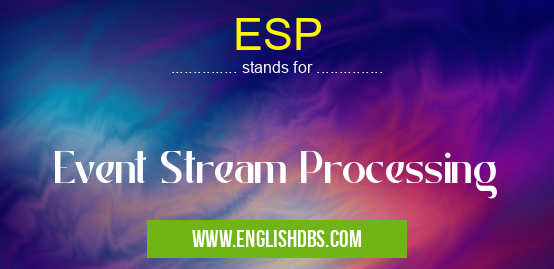What does ESP mean in TECHNOLOGY
ESP, which stands for Event Stream Processing, is a powerful technology that enables real-time analysis and processing of large volumes of event data. It empowers organizations to gain valuable insights, make informed decisions, and respond swiftly to changing business conditions.

ESP meaning in Technology in Computing
ESP mostly used in an acronym Technology in Category Computing that means Event Stream Processing
Shorthand: ESP,
Full Form: Event Stream Processing
For more information of "Event Stream Processing", see the section below.
» Computing » Technology
ESP Meaning in COMPUTING
ESP is a data processing technique that involves continuously ingesting, processing, and analyzing streams of events in real time. These events can be generated from various sources, such as IoT devices, user interactions, transaction logs, and social media platforms.
ESP Full Form
The full form of ESP in COMPUTING is Event Stream Processing.
What does ESP Stand for?
ESP stands for the ability to process continuous streams of events in real time, providing organizations with the power to analyze and respond to data as it is generated.
Key Features of ESP
- Real-time Processing: ESP processes data as it arrives, enabling organizations to gain insights and make decisions without delay.
- Scalability: ESP systems can handle massive volumes of data, ensuring that organizations can process and analyze data from multiple sources.
- Flexibility: ESP systems can be customized to meet specific business requirements, allowing organizations to tailor their data processing to their unique needs.
Benefits of ESP
- Enhanced Decision-making: ESP provides real-time insights that empower organizations to make informed decisions based on up-to-date information.
- Fraud Detection: ESP can detect and respond to fraudulent activities in real time, protecting organizations from financial losses.
- Predictive Analysis: ESP enables organizations to identify patterns and predict future events, allowing them to proactively mitigate risks and capitalize on opportunities.
Applications of ESP
ESP has a wide range of applications across various industries, including:
- Financial Services: Fraud detection, risk management, and personalized marketing.
- Healthcare: Real-time patient monitoring, disease surveillance, and drug discovery.
- Telecommunications: Network monitoring, anomaly detection, and customer experience optimization.
Essential Questions and Answers on Event Stream Processing in "COMPUTING»TECHNOLOGY"
What is Event Stream Processing (ESP)?
ESP is a real-time data processing technique that continuously analyzes and processes streams of events as they occur. It enables businesses to identify patterns, anomalies, and correlations in data in near real-time, allowing for immediate decision-making and response.
What are the benefits of using ESP?
ESP offers several advantages, including:
- Real-time insights: Immediate analysis of data as it is generated, providing up-to-the-minute insights and alerts.
- Fraud and anomaly detection: Early identification of suspicious activities or patterns in data, enabling swift response to prevent losses.
- Predictive analytics: Leverage historical data and real-time events to predict future outcomes and make proactive decisions.
- Personalized customer experiences: Analyze customer behavior in real-time to deliver tailored and relevant experiences at the right moment.
What types of data can be processed using ESP? A: ESP can handle various types of data, such as: - Clickstream data: Website and application usage patterns. - Sensor data: Data from IoT devices, such as temperature readings or motion detection. - Financial transactions: Payment processing and account activity. - Social media dat
ESP can handle various types of data, such as:
- Clickstream data: Website and application usage patterns.
- Sensor data: Data from IoT devices, such as temperature readings or motion detection.
- Financial transactions: Payment processing and account activity.
- Social media data: Tweets, posts, and user interactions.
What are the challenges associated with ESP?
ESP implementation can face challenges, including:
- High data volume: Managing and processing vast amounts of data in real-time can be resource-intensive.
- Latency: Ensuring minimal delay in event processing is crucial for effective real-time analysis.
- Data integration: Integrating data from different sources and formats can be complex.
What are the applications of ESP in different industries?
ESP has wide-ranging applications in various industries, such as:
- Finance: Fraud detection, risk management, and portfolio optimization.
- Retail: Customer behavior analysis, personalized recommendations, and demand forecasting.
- Manufacturing: Equipment monitoring, predictive maintenance, and quality control.
- Healthcare: Patient monitoring, disease outbreak detection, and drug development.
Final Words: ESP is a transformative technology that enables organizations to harness the power of event data in real time. By continuously processing and analyzing data, ESP provides valuable insights, empowers informed decision-making, and unlocks new opportunities for innovation and growth.
ESP also stands for: |
|
| All stands for ESP |
